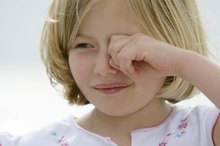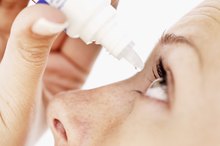Are Eye Drops Safe for Kids?
Eye drops allow direct delivery of medicine to the eyes without possible side effects that can occur with oral medications. **Eye drops are the preferred form of medication delivery for a variety of eye ailments, but parents sometimes worry whether they are safe for kids.
If you are experiencing serious medical symptoms, seek emergency treatment immediately.
When administered properly and used as prescribed or directed, eye drops are generally a safe form of medication delivery for children. Talk with your child’s doctor if you have questions about when and how to safely use eye drops 4. **
Eye Allergy Drops
Different types of eye drops can be used in children to treat symptoms of eye allergies, such as itchiness, redness and irritation.
Artificial tears, which can be used in children of all ages, provide temporary relief by rinsing the allergy-triggering substances from the eyes. Preservative-free brands are available if this is a concern.
Eye drops containing decongestants, antihistamines or both are also available over the counter. Prescription eye drops might be recommended if your child has severe, persistent eye allergy symptoms. Age restrictions for these various types of allergy eye drops differ, depending on the medicine and formulation.
For over-the-counter eye drops, do not use on a child younger than indicated on the product label. Use prescription eye drops only for the child for whom they were prescribed, and administer specifically as directed.
- Different types of eye drops can be used in children to treat symptoms of eye allergies, such as itchiness, redness and irritation.
Antibiotic Drops
Bloodshot Eyes in Children
Learn More
Prescription antibiotic eye drops are used to treat bacterial eye infections in children and adults 4.
Keep in mind, however, that most cases of pink eye in kids are due to a viral infection and do not require antibiotic treatment. The FDA-approved age for use of antibiotic eye drops varies, depending on the specific medication in the drops. Most are approved for use in children older than 1 or 2 years old, although some are approved for younger babies and others are recommended only for children older than age 6. Antibiotic eye drops can potentially cause an allergic reaction in some children and other possible side effects, which you'll want to discuss with your doctor.
- Prescription antibiotic eye drops are used to treat bacterial eye infections in children and adults 4.
- Keep in mind, however, that most cases of pink eye in kids are due to a viral infection and do not require antibiotic treatment.
Other Types of Eye Drops
Children with less common eye ailments -- such as lazy eye or amblyopia, and pediatric glaucoma -- are often treated with prescription eye drops and other forms of therapy.
Eye drop use may be recommended short or long term, and the choice of medication depends on your child's condition and progress. Age restrictions and possible side effects differ according to the medication used. Your child’s eye doctor will discuss the potential benefits and risks of these medicines, and side effects to be watchful for.
- Children with less common eye ailments -- such as lazy eye or amblyopia, and pediatric glaucoma -- are often treated with prescription eye drops and other forms of therapy.
- Eye drop use may be recommended short or long term, and the choice of medication depends on your child's condition and progress.
Safe Administration
Eye Growth From Childhood to Adulthood
Learn More
It’s important to follow some safety precautions when administering eye drops into your child’s eyes. The American Academy of Pediatrics recommends these steps: -- Warm the medicine in your hands if it’s been in the refrigerator. -- Wash your hands with soap and water. -- Wash wash each of your child’s eyes with a clean, warm, damp washcloth. Wipe from the nose side of the eye outward. You might need to leave the washcloth on the child’s eye for a minute or two if there is heavy crusting. -- Lie your child on his back with a pillow under his shoulders so that his head is tilted slightly back. -- Ask your child to look up and to the opposite side. Having another person hold a favorite toy in a location that will prompt your child to look in the desired direction can be helpful with young children. -- Rest your wrist on the child’s forehead. **This will steady your hand so you can get the medicine into the eye, can helps prevent you from accidentally poking your child’s eye if she starts to fuss.
** -- Lower the applicator to about an inch away from the child's eye and drop the medicine into the lower eyelid. Do not touch the applicator to the eye or the surrounding skin.
- It’s important to follow some safety precautions when administering eye drops into your child’s eyes.
- You might need to leave the washcloth on the child’s eye for a minute or two if there is heavy crusting.
- --
Considerations
Talk with your doctor if your child has an eye problem that you think might require eye drops.
She can advise you about whether your child needs to be seen, recommend treatment options, and relay any safety precautions you should follow.
For example, there may be special considerations for eye drop use in children who wear contact lenses. Seek immediate medical attention if your child complains of blurry vision or other visual changes, or has sustained an eye injury.
Reviewed and revised by: Tina M. St. John, M.D.
- Talk with your doctor if your child has an eye problem that you think might require eye drops.
Related Articles
References
- Pediatric Ophthalmology and Strabismus, 2nd Edition; Kenneth W. Wright and Peter H. Spiegel
- HealthyChildren.org: How to Give Eye Drops and Eye Ointment
- Miyamoto RT. Traumatic Perforation of the Tympanic Membrane. Merck Manual Professional Version. Updated March 2019.
- Mezger E, Wendler O, Mayr S, Bozzato A. Anaphylactic reaction following administration of nose drops containing benzalkonium chloride. Head Face Med. 2012;8:29. doi:10.1186/1746-160X-8-29
- Burton M, Aaron K, Warner L. Ear drops for the removal of ear wax. Cochrane Data Syst Rev. 2016;4:CD012171. doi:10.1002/14651858.CD012171
Writer Bio
Leigh Good has been writing for magazines and newspapers for more than 10 years. Her work has been published in numerous print and online publications. Good has a bachelor's degree in print journalism from Georgia State University.









